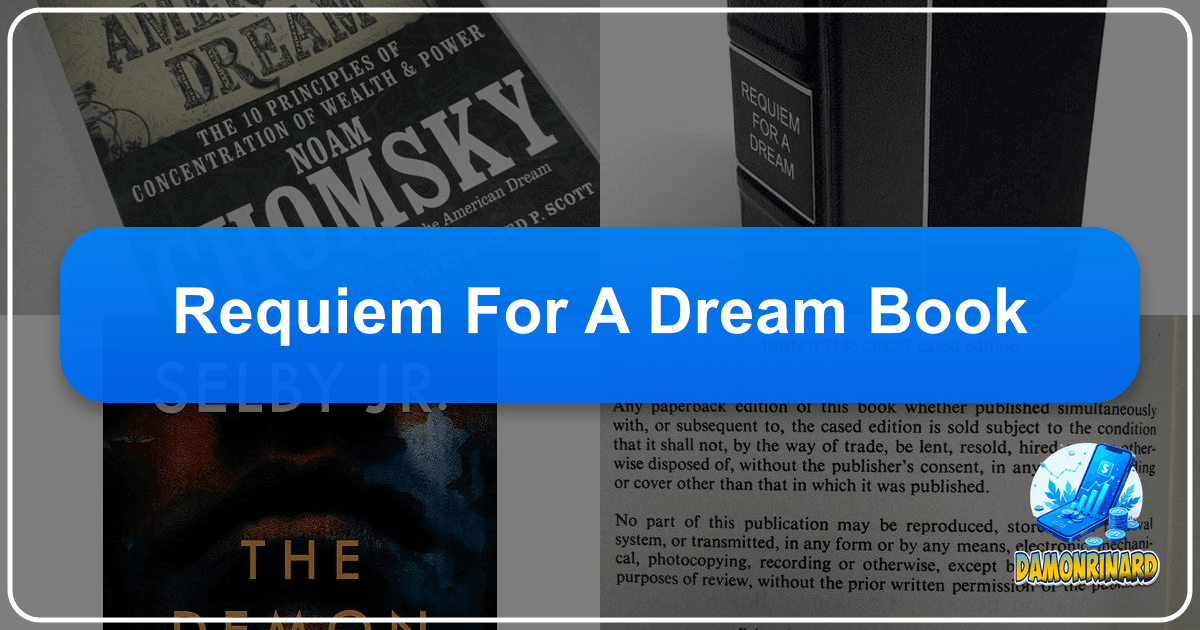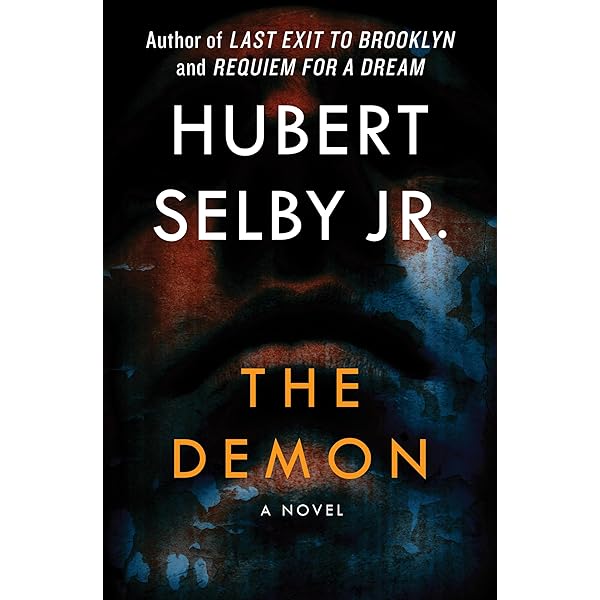Requiem For A Dream Book: A Descent into the Human Psyche and Its Enduring Legacy

Hubert Selby Jr.’s Requiem For A Dream stands as a seminal work in American literature, a stark and unflinching exploration of addiction, shattered aspirations, and the darker recesses of the human condition. Published in 1978, this novel, much like its predecessors Last Exit to Brooklyn and The Room, cemented Selby Jr.’s reputation as a master of gritty realism, a writer unafraid to confront the most uncomfortable truths of society and individual despair. For readers seeking not just a story but an experience that challenges and provokes, Requiem For A Dream remains a powerful and unforgettable journey.
Lbibinders.org champions books that leave an indelible mark, and Selby’s work certainly fits this description. It’s a testament to the power of literature to reflect, dissect, and sometimes even heal, by forcing us to look directly at what we might otherwise ignore. From the perspective of “Books” (Genres, Classics, Bestsellers, New Releases, Book Reviews), Requiem For A Dream is difficult to categorize neatly. It transcends simple genre classifications, blending elements of naturalism, existentialism, and social commentary. While perhaps not a traditional “bestseller” in its initial run, its enduring presence, academic study, and eventual blockbuster film adaptation have elevated it to the status of a modern classic, continually generating new “book reviews” and scholarly interest. Its themes resonate as powerfully today as they did upon its release, a testament to its timeless relevance.

The Unflinching Gaze of Hubert Selby Jr.
To understand Requiem For A Dream, one must first understand the remarkable individual behind its raw prose: Hubert Selby Jr. (as discussed under “Authors” on Lbibinders.org, focusing on Biographies, Writing Style, and Inspirations). His life story is as compelling and harrowing as any of his fictional narratives, deeply influencing the powerful and often brutal authenticity of his writing.
A Life Forged in Fire: The Author’s Journey
Hubert Selby Jr.’s “biography” is crucial context for his literary output. Born in Brooklyn in 1928, his youth was marked by hardship and illness. During World War II, at the age of 17, he served in the merchant marine and contracted tuberculosis, a condition that would plague him for the rest of his life. He underwent multiple surgeries, lost a lung, and spent years in and out of hospitals, often bedridden and grappling with severe pain. It was during these extended periods of recovery, facing the prospect of an abbreviated life and seeking a means of expression, that he began to write. He had no formal literary training; his education was primarily in the school of hard knocks and the quiet desperation of hospital wards.

This intensely personal struggle with illness, pain, and isolation became a wellspring for his “inspirations.” Selby Jr. observed the world from a unique vantage point, scrutinizing the human spirit under immense pressure. He witnessed the fringes of society, the hopes and failures of ordinary people, and the ways in which individuals coped – or failed to cope – with their circumstances. His experiences instilled in him a profound empathy for the downtrodden and a fierce determination to represent their lives without sentimentality or judgment. He was not interested in moralizing, but in simply showing things as they are, in all their stark reality. This commitment to truth, however unsettling, became the cornerstone of his “writing style.”
Raw Prose and Unsparing Realism: Selby’s Writing Style
Selby Jr.’s “writing style” is instantly recognizable and profoundly impactful, a defining characteristic that sets his “famous works” apart. He famously rejected conventional punctuation, often forgoing quotation marks, paragraph breaks, and even standard capitalization, particularly in his earlier novels. This was not a stylistic affectation but a deliberate choice aimed at creating a sense of immediacy, a stream-of-consciousness flow that mimicked the chaotic internal worlds of his characters. His prose is stark, visceral, and almost musical in its rhythm, drawing the reader into the characters’ thoughts and sensations without the usual filtering of formal grammar.

He wrote in a language that was as raw and unpolished as the lives he depicted, utilizing vernacular speech patterns and a direct, unadorned vocabulary. This “unflinching pen” approach was revolutionary and often controversial, leading to accusations of obscenity and nihilism. However, critics and readers who delved deeper recognized it as a powerful tool for conveying authenticity. His sentences often tumble forward, building momentum, reflecting the accelerating desperation of his characters. This technique demands active engagement from the “reading habits” of his audience, pushing them to connect with the emotional core rather than simply follow a narrative. His works, including Requiem For A Dream, serve as powerful examples for aspiring authors on Lbibinders.org, demonstrating how breaking traditional rules can lead to profound artistic statements and a unique “voice.”
Requiem For A Dream: A Narrative of Descent
At the heart of Requiem For A Dream is a narrative that meticulously charts the decline of four interconnected lives, each chasing a different, ultimately destructive, dream. This section delves into the book’s core themes and structure, aligning with “Reading and Learning” (Summaries, Educational Value, Life Lessons) and “Books” (Genres, Book Reviews).
The Shattered American Dream: Core Themes and Plot Summary
The novel’s “summary” focuses on the intertwined fates of Harry Goldfarb, a small-time heroin dealer; his girlfriend Marion Silver, an aspiring fashion designer; his best friend Tyrone C. Love, also a dealer; and Harry’s mother, Sara Goldfarb, a lonely widow obsessed with appearing on a television game show. Each character harbors a vision of a better future, a personal “American Dream” that they believe will provide happiness, respect, and escape from their mundane or painful realities.
Sara’s dream is perhaps the most poignant and relatable. Convinced she will be a guest on her favorite TV show, she becomes fixated on losing weight and looking good for the camera. She consults a doctor who prescribes amphetamines – diet pills – which soon spiral into a severe addiction. Her once tidy apartment descends into squalor, her reality distorts, and her mind unravels under the constant bombardment of imagined adulation and fear.
Meanwhile, Harry, Marion, and Tyrone pursue their own version of success through drug dealing. Their initial ventures are promising, offering a glimpse of luxury and independence. Harry and Marion dream of opening a boutique, a symbol of their creative aspirations and a legitimate future. Tyrone envisions escaping the racial prejudice he faces and building a life of respect. However, their illicit enterprise is inherently unstable, and their own growing heroin addictions begin to consume their lives, talents, and relationships.
Selby Jr. masterfully portrays the insidious nature of addiction, not just to illegal drugs, but to any obsessive pursuit that promises escape or transcendence. He shows how these “dreams,” once catalysts for hope, slowly morph into nightmares, driving the characters further and further into desperation, delusion, and degradation. The narrative is relentlessly bleak, culminating in horrifying climaxes for all four protagonists, illustrating the devastating consequences of their choices and the powerful, almost inescapable, grip of their addictions. The “educational value” of this raw depiction lies in its uncompromising portrayal of the destructive cycle of dependency, offering profound “life lessons” about the perils of escapism and the illusion of quick fixes. It’s a powerful cautionary tale, often discussed in “book reviews” for its unflinching gaze.
Beyond Morality: The Book’s Enduring Message
One of the most striking aspects of Requiem For A Dream is Selby Jr.’s refusal to impose overt moral judgments. He doesn’t preach; he merely presents. This approach allows the reader to engage directly with the characters’ experiences, to feel their hopes and their pain, their brief moments of euphoria, and their prolonged agony. This dispassionate yet deeply empathetic stance is a hallmark of the book’s enduring “literary influence.” It challenges readers to confront their own preconceptions about addiction and poverty, urging them to see the humanity, however broken, beneath the surface.
The “educational value” extends beyond simple anti-drug messaging. It’s a profound commentary on the nature of desire itself, the societal pressures that fuel our aspirations, and the fragility of the human mind when confronted with overwhelming despair. The book dissects the “cultural impact” of promises of easy success and instant gratification, whether through television, consumerism, or illicit substances. Its power lies in its ability to evoke a deep sense of pathos and understanding, rather than merely revulsion. This makes it a crucial text for “reading and learning,” providing a foundation for discussions on social responsibility, mental health, and the complexities of human motivation. For any “book review,” this refusal to simplify complex issues is often highlighted as one of its greatest strengths.
From Page to Screen: Cultural Resonance and Legacy
Requiem For A Dream didn’t just exist as a standalone novel; its visceral power made it ripe for “adaptations” and ensured its lasting “cultural impact.” The transition from the written word to other media, particularly film, amplified its message and brought Selby Jr.’s dark vision to a wider audience, solidifying its place in contemporary culture. This aligns with Lbibinders.org’s focus on “Cultural Impact” (Literary Influence, Adaptations, Awards, Communities).
Beyond the Page: Cinematic and Cultural Resonance
The most prominent “adaptation” of Requiem For A Dream is Darren Aronofsky’s critically acclaimed 2000 film, which brought Selby Jr.’s narrative to a global audience. Aronofsky, a prodigious talent, managed to translate the novel’s chaotic energy and raw emotional intensity into a cinematic language that mirrored Selby’s prose. The film famously uses rapid-fire montages, split screens, and disorienting camera work to immerse the viewer in the characters’ subjective experiences, particularly the escalating horrors of their addictions. The iconic score by Clint Mansell, featuring the String Quartet, became synonymous with the film’s tension and despair, further embedding the story into the collective consciousness.
This “adaptation” was not merely a retelling but an artistic reinterpretation that faithfully captured the novel’s spirit while innovating in its medium. It received widespread critical acclaim, garnering numerous “awards” and nominations, including an Academy Award nomination for Ellen Burstyn’s harrowing performance as Sara Goldfarb. The film’s success significantly boosted the novel’s profile, introducing new generations of readers to Selby Jr.’s powerful “literary influence.” It became a touchstone for discussions on addiction, mental health, and the darker side of the American Dream, fostering “communities” of readers and viewers who were profoundly moved by its message.
The “cultural impact” of Requiem For A Dream, both book and film, extends far beyond its initial release. It is frequently referenced in media, art, and academic discourse, serving as a powerful symbol of the destructive nature of addiction and the fragility of human hope. Its unflinching depiction means it is often cited in discussions about the responsibilities of art to confront uncomfortable truths, and its place in the literary canon is secure, recognized for its raw honesty and enduring relevance.
The Role of Libraries: Preserving Uncomfortable Truths
In the context of works like Requiem For A Dream, “libraries” – whether “public libraries,” “digital libraries,” or those housing “rare collections” and “archives” – play a crucial role. They are not merely repositories of information but guardians of cultural memory, ensuring that even the most challenging and controversial texts remain accessible. For a book that pushes boundaries and explores such difficult subject matter, libraries are essential.
“Public libraries” across the globe make Requiem For A Dream available to anyone seeking to engage with its powerful narrative, democratizing access to literature that might otherwise be overlooked. “Digital libraries” further expand this reach, allowing readers to access the novel in various formats, fostering “reading habits” that transcend geographical limitations. Furthermore, academic and specialized libraries, through their “rare collections” and “archives,” preserve early editions, Selby Jr.’s manuscripts, and critical analyses, providing invaluable resources for scholars and students interested in his “writing style,” “inspirations,” and the historical context of his “famous works.”
These institutions ensure that Selby Jr.’s unique voice and the profound “educational value” of his stories are not lost. They facilitate critical inquiry, allowing “communities” to study, discuss, and learn from literature that, while sometimes painful, offers deep insights into the human condition. Lbibinders.org, through its focus on libraries, understands that these institutions are vital in keeping alive the conversations sparked by books like Requiem For A Dream, fostering intellectual growth and cultural understanding.
Lessons from the Abyss: Educational Value and Life Lessons
The “educational value” of Requiem For A Dream lies not in prescribing solutions but in illuminating problems with unparalleled clarity. For “reading and learning,” it offers myriad “life lessons” that transcend the specific context of addiction. It serves as a stark reminder of the dangers of delusion, the corrosive power of unfulfilled desires, and the ease with which individuals can descend into self-destruction when their foundations are shaken.
One significant “life lesson” is the importance of realistic aspirations and the perils of escapism. Each character seeks an easy way out, a magical solution to their problems, which ultimately proves to be their undoing. The book underscores the idea that true fulfillment often comes from confronting reality, however harsh, rather than retreating into fantasy or substance abuse. It also highlights the breakdown of familial and social support systems, illustrating how isolation can exacerbate vulnerability to destructive behaviors.
For students and general readers alike, engaging with Requiem For A Dream can foster empathy and critical thinking skills. It prompts reflection on societal issues such as poverty, the efficacy of the healthcare system (as seen in Sara’s misguided treatment), and the pervasive nature of addictive behaviors in various forms. It encourages discussions about resilience, the nature of hope, and the consequences of systemic neglect. For those developing their “reading habits,” Selby Jr.’s work challenges conventional narrative structures, broadening their appreciation for diverse literary forms and the power of uncompromising storytelling.
Lbibinders.org emphasizes that books are not just for entertainment but for growth and understanding. Requiem For A Dream, despite its dark subject matter, provides a powerful conduit for such growth, forcing readers to examine uncomfortable truths about themselves and the society they inhabit. It’s a challenging read, but one that offers profound insights into the human struggle, making it an essential text for anyone committed to deep “reading and learning.”
In conclusion, Hubert Selby Jr.’s Requiem For A Dream remains a potent and unforgettable work of literature. Its raw honesty, unique “writing style,” and uncompromising exploration of addiction and shattered dreams have solidified its place as a modern classic. From its profound “literary influence” and powerful “adaptations” to its enduring “educational value” and the critical role of “libraries” in preserving its message, the book continues to resonate deeply within “communities” of readers and scholars. Lbibinders.org proudly acknowledges its significance as a testament to the power of storytelling to confront, provoke, and ultimately, enlighten. It is a book that doesn’t just tell a story; it imprints itself upon the reader’s consciousness, a haunting melody that echoes long after the final page is turned.